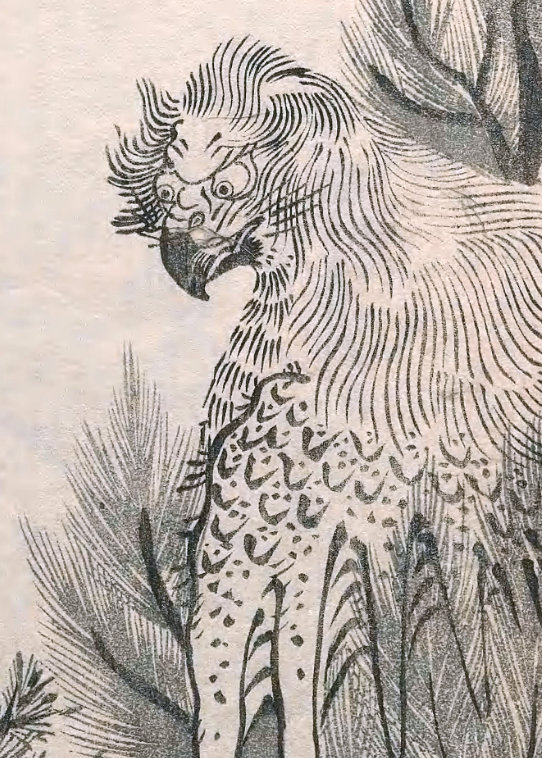Tengu are a type of legendary creature found in Shinto belief. They are considered a type of yōkai (supernatural beings) or Shinto kami (gods or spirits). The Tengu were originally thought to take the forms of birds of prey and a monkey deity, and they were traditionally depicted with human, monkey, and avian characteristics. Sarutahiko Ōkami is considered to be the original model of Konoha-Tengu (a supernatural creature with a red face and long nose), which today is widely considered the Tengu’s defining characteristic in the popular imagination. Buddhism long held that the Tengu were disruptive demons and harbingers of war. Their image gradually softened, however, into one of protective, if still dangerous, spirits of the mountains and forests. The tengu in art appears in a variety of shapes. It usually falls somewhere in between a large, monstrous bird and a wholly anthropomorphized being, often with a red face or an unusually large or long nose. Early depictions of tengu show them as kite-like beings who can take a human-like form, often retaining avian wings, heads, or beaks. The tengu’s long nose seems to have been conceived in the 14th century, likely as a humanization of the original bird’s bill. Some Japanese scholars have speculated that the tengu’s image derives from that of the Hindu eagle deity Garuda, who was pluralized in Buddhist scripture as one of the major races of non-human beings. Like the tengu, the garuda are often portrayed in a human-like form with wings and a bird’s beak.
| Alias Tengu (天狗) |
| Real Names/Alt Names “Heavenly Dog” |
| Characteristics Bird-themed, Yōkai, Medieval Age, Japanese |
| Creators/Key Contributors Toriyama Sekien, ○ |
| First Appearance Japanese folklore |
| First Publisher ○ |
| Appearance List Nihon Shoki (日本書紀, 720), Gazu Hyakki Yagyō (画図百鬼夜行, “The Illustrated Night Parade of a Hundred Demons” or The Illustrated Demon Horde’s Night Parade, 1776) Vol. 1 “Yin” |
| Sample Read Gazu Hyakki Yagyō Vol. 1 “Yin” (1776) [Smithsonian] |
| Description Tengu are a type of legendary creature found in Shinto belief. They are considered a type of yōkai (supernatural beings) or Shinto kami (gods or spirits). The Tengu were originally thought to take the forms of birds of prey and a monkey deity, and they were traditionally depicted with human, monkey, and avian characteristics. Sarutahiko Ōkami is considered to be the original model of Konoha-Tengu (a supernatural creature with a red face and long nose), which today is widely considered the Tengu’s defining characteristic in the popular imagination. Buddhism long held that the Tengu were disruptive demons and harbingers of war. Their image gradually softened, however, into one of protective, if still dangerous, spirits of the mountains and forests. The tengu in art appears in a variety of shapes. It usually falls somewhere in between a large, monstrous bird and a wholly anthropomorphized being, often with a red face or an unusually large or long nose. Early depictions of tengu show them as kite-like beings who can take a human-like form, often retaining avian wings, heads, or beaks. The tengu’s long nose seems to have been conceived in the 14th century, likely as a humanization of the original bird’s bill. Some Japanese scholars have speculated that the tengu’s image derives from that of the Hindu eagle deity Garuda, who was pluralized in Buddhist scripture as one of the major races of non-human beings. Like the tengu, the garuda are often portrayed in a human-like form with wings and a bird’s beak. |
| Source Tengu – Wikipedia |


